|
FAQs about Merulinid Corals
1
Related Articles: Merulinids, SPS
Corals,
Related FAQs: Merulinids 2, & FAQs on: Merulinid Identification, Merulinid Behavior, Merulinid Compatibility, Merulinid Selection, Merulinid Systems, Merulinid Feeding, Merulinid Disease, Merulinid Reproduction/Propagation,
& Stony/True Coral,
Coral System Set-Up, Coral System Lighting, Stony Coral Identification, Stony Coral Selection, Coral Placement, Foods/Feeding/Nutrition, Disease/Health, Propagation, Growing Reef Corals, Stony Coral Behavior, SPS Identification, SPS Behavior, SPS
Compatibility, SPS Selection,
SPS Systems, SPS Feeding, SPS
Disease, SPS Reproduction,
At right: a Hydnophora exesa colony in
captivity.
|
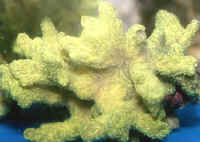
|
|
Montipora capricornis Compatibility 03/31/2008 Hey Crew.
<<Good Morning, Andrew today>> I hope the mice
aren't playing too much while the cat is away. I have a
"professional compatibility opinion" question for you.
I was in my LFS today and noticed a very nice (4" wide and
6" long) coral that I believe to be a Montipora capricornis.
(See attached picture--do you agree?). <<Agreed>>
This coral is in the "all corals in this tank are $25"
tank. I couldn't believe the LFS is selling this for only $25
as I've seen similar corals demanding much higher prices, so
I asked one of the clerks why it was so cheap and he said that
they are trying to get rid of it because it's been at the
store for over 2 weeks with no takers. He tells me that it is an
aquacultured "cup coral" that doesn't have the
coloring that most people like. This coral would look great in my
tank, so I came home and did some research on compatibility and
am a little concerned about its ability to survive/thrive given
my other animals (mostly, my Corallimorphs). I have a 110 gallon
display with 95 lbs of LR and a 30 gallon refugium (DSB, 10 lbs
LR, and large clump of Chaeto). Lighting is 2x250W HQIs (20,000K)
driven by 2 IceCap ballasts and 4x65W actinic PCs. My circulation
is about 15 x per hour between my return pump and my internal
power heads. My coral livestock list is as follows: Corallimorphs
(positioned throughout my tank): 8 small green hairy mushrooms on
one rock 8 medium green Rhodactis mushrooms on one rock 1 small
purple Rhodactis mushroom 14 small red mushrooms spread
throughout my tank 1 medium orange Ricordea mushroom 3 small
cream colored mushrooms on one piece of Tonga branch Soft Corals:
2 large colonies Pulsing Xenia 2 large Capnellas 1 large
Dendronephthya (9 months and thriving!) 1 large red pipe organ
(Tubipora musica) LPS: 1 Pacific Open Brain (Trachyphyllia) 5
polyps candy cane coral (Caulastrea echinulata). I run two 1-cup
portions of activated carbon in my sump that I change out every 2
weeks to help reduce any allelopathy. At $25, this isn't a
huge investment by any stretch, but I don't want to purchase
this coral only to put it in an environment in which it won't
thrive or survive. There is an empty spot about half way up my
tank that is in a relatively high-flow area that would be a
perfect spot for this coral. What do you think? <<Given
enough space / distance between this and other corals, I see no
reason why you could not house this in your system>> Thanks
for your insight/thoughts! Andy <<Thanks for questions,
hope this helps. A Nixon>>
Re: Montipora capricornis Compatibility
04/01/2008 Andrew, <<Andy>> Someone opined to me
that this coral is a Merulina ampliata, not a Monti cap, but the
pictures of Merulina that I've been able to find don't
resemble this coral. However, after reading WWM and elsewhere,
the ridges on this coral make me wonder whether it may be a
Merulina, but . . . Any thoughts on the proper ID of this coral
and, if a Merulina, any difference in your original opinion that
it should do okay in my display? Closer pic is here:
http://i262.photobucket.com/albums/ii81/abulgin/DSC_0654.jpg
<<Ampilata do not roll up as the Monti Cap does. Its a more
flat plating coral. I will stick with Montipora
capricornis>> Thanks again! Andy <<Thanks for the
follow and query. A Nixon>>
Re: Montipora capricornis Compatibility -
04/1/08 Andrew, <<Hello again>> Thanks for the
reply. This picture is what got me thinking maybe we were wrong:
http://whelk.aims.gov.au/coralsearch/html/201-300/Pix/240-02.htm
<<I still feel confident of this being a Monti cap. If you
review the following photo's of the Merulina ampliata, to me,
I can see the difference..
http://www.reef-guardian.com/fiches-coraux-pic-76.html ..Flat,
not rose, higher pronounced ridges.>> <<Thanks, A
Nixon>>
|
|

|
help with coral, ID, lambda....
3/6/08 Hi Crew! Donna here needing help again. A local reefer
gave me a frag of this coral about 4 months ago. She told me it was
a Pink Birdsnest <... a Poritid? Mmm, no... Looks more like a
Hydnophora species; a Merulinid...> and she had it under PC
lighting so I thought it would be okay in my tank. A 20L with PC
lights. I put it pretty close to the top. It was doing fine all
this time and then I decided to change my lights. It was under 130W
PC and I just got the Hagen Glo T5 HO 2X29W one actinic one
daylight. I did this 4 days ago and now the coral looks like this.
Am I correct in assuming the light is too strong? I moved it lower
in the tank for now until I receive your response. Thank you in
advance! Donna P.S. the pictures are reversed I couldn't figure
out how to get them in the proper order...Sorry <Mmm, I would
borrow (check with the stores about, or the local marine/reef club)
a PAR meter... Too "guessing" to gauge how much useful
light/change otherwise here. I would in the meanwhile use a bit of
shading material as discussed here:
http://wetwebmedia.com/acclimcoralslight.htm
Bob Fenner> |
|
[1]%20merulinid%20birds%20nest.jpg) 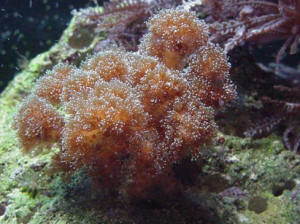
|
Coral Identification 2/2/08First
off I just want to say I love the site, it has helped me lots and
lots. A couple weeks ago a friend gave me a couple pieces of coral
that he no longer wanted. I thought they would go perfect in my 8g.
Any info on this piece of coral will be appreciated. <... looks
like a Hydnophora species to me...> The tank has been going for
almost a year now with no major problems. Over the tank there is a
70w viper clamp. 15lbs of LR, about a 5 inch live sand bed, 2 small
Turbos, 1 small cinnamon clown, 1 watchman goby, 1 peppermint
shrimp, 4 blue leg hermits, Cladiella sp, 1 green frogspawn, a
small clove polyps, small blue maxima and a couple of feather
dusters. <Read here: http://www.wetwebmedia.com/merulinidae.htm
and the linked files above...
BobF> |
|
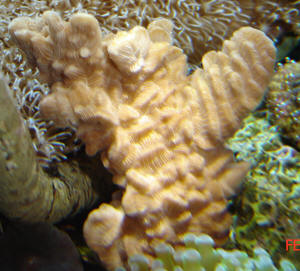
|
|
Hydnophora Dying - 09/08/07 I wondered if you
could help me with my Hydnophora frag which has been doing well i
my tank for half a year now, recently i have been seeing major
tissue recession from the main body, and exposure of the
skeleton, its gradually got worse and worse and i don't know
what to do i wondered if you can be of any help at all. All my
parameters of course are fine, <Hmm... what does
"fine" mean exactly? These corals need your water
chemistry to be as close to natural sea water as you can get it.
(i.e. salinity 1.025-1.027sg, calcium 410 to 420ppm, alkalinity 3
to 4 mEq/L, etc. Always keep in mind that what's
"fine" for one coral might not be so fine for another.
You'd be surprised what I can get some species of Zoanthids
and clove coral to grow in. But Hydnophora is a bit more
picky.> recently lost a Ricordea which may have caused this
what do you think? <I doubt it, unless maybe if the tank is
really small.> The Ricordea did start to disintegrate due to
too high water flow causing it to be moved around. <It might
not be disintegrating. It might have just scrunched up and let go
to find a better spot.> please help it looks so gorgeous and i
understand they are not the easiest of corals to keep but that is
why i took up the challenge, but my hopes have been dashed by
this recent event and i am at a loose end. I hope the picture
helps you with your diagnosis. <These corals often suffer
frightening tissue recession before getting truly settled into a
tank. But they're also known to make some heroic recoveries.
Do you feed it anything? If not, that's likely part of the
problem. Keep it under strong light and moderate water flow and
start target feeding it. If you have to, turn the pumps off for
an hour or so while feeding.> Yours Laurence Sykes <Good
luck, Sara M.>
Hydnophora Dying 9/10/07 I wondered if
you could help me with my Hydnophora frag <Forgive me if I
already answered this email. I can't seem to find my response
anywhere so I'm afraid maybe I never sent it. Anyway, here it
goes again...> which has been doing well i my tank for half a
year now, recently i have been seeing major tissue recession from
the main body, and exposure of the skeleton, its gradually got
worse and worse and i don't know what to do i wondered if you
can be of any help at all. <This is typical for Hydnophora
which is not yet settled into a tank.> All my parameters of
course are fine, <Hmm... what is "fine" exactly?
What's fine for one coral might not be fine for another.
Hydnophora need water parameters as close to natural seawater as
possible (calcium 410 to 420ppm, salinity 1.025 to 1.027,
etc.)> recently lost a Ricordea which may have caused this
what do you think? <Highly unlikely unless the tank is really
small.> The Ricordea did start to disintegrate due to too high
water flow causing it to be moved around. <It might not be
disintegrating. It likely scrunched up and let go to try to find
a better spot.> please help it looks so gorgeous and i
understand they are not the easiest of corals to keep but that is
why i took up the challenge, but my hopes have been dashed by
this recent event and i am at a loose end. <It's quite
common for these corals to suffer frightening tissue recession
when not well established in a new tank. Fortunately, they're
also capable of heroic recoveries. Do you feed it? If not, that
might be part of the problem. Try target feeding it (turn off the
pumps for an hour or so if you have to).> I hope the picture
helps you with your diagnosis. <not doomed yet... could
definitely come back with some TLC> Yours Laurence Sykes
<Good luck,
Sara M.>
|
|
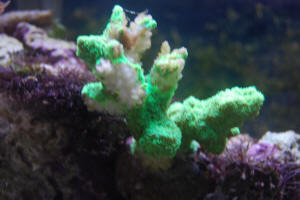
|
|
Coral Recession... Merulina - 08/05/07 Hi, <Hi Brian,
Mich with you again.> You helped me identify this a few weeks
ago and it had been doing fine. Now I am noticing some recession.
<I am not surprised. This coral is not generally not easily
kept in captivity. Merulina often suffer from tissue recession,
bleaching, decalcification and overall failure to thrive and the
causes are seldom well understood.> Any ideas? <Tissues may
be compromised by sediments and contact with other corals>
What can I do to slow, stop it? <Is difficult to say, as the
causes are not often able to be determined. You will need to keep
sediment off of this coral. Keeping your water quality as high as
possible with frequent water changes and regular carbon
replacement may help. Borneman recommends generally leaving this
coral alone and untouched. He further recommends keeping this
coral under strong lighting and a good distance from any
potential allelopathic organisms. Merulina grow quite slowly so
if, and a big if here, it does recover it will likely take a good
bit of time. I'm sorry, I wish I had better news for you.>
See attached pic. <Got it. Thanks, Mich>
Coral Recession... Merulina - 08/05/07 <Hello again
Brian, Mich here.> Guess I deserve it for not doing my
research before I purchased. <We are all human and hopefully
we learn and grow from our mistakes.> Need to practice what I
preach. <Yes, don't we all?> Actually we need a mobile
solution to be able to look something up at a LFS in the case we
see something we like that we do not know what it is. Here's
an idea for a new web site. <<RMF has seen some shops
making Net access avail... where folks can easily "look
up" at least what there is to find thus>> You email a
picture of a coral and it emails back info about it. Just need a
coral identifier system :). <Heehee! Actually Jake Adams is
working on a mobile coral reference guide that can be down loaded
to your MP3 player. See his website here:
http://www.coralidea.com I hope you find this helpful.
Mich>
|
|
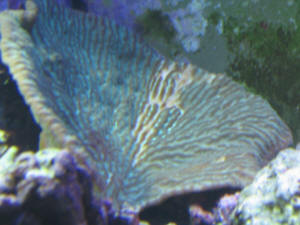
|
|
Id...Possibly Merulina ampliata - 07/03/07 I
can't find the following in any of my books, any ideas?
<Hi Brian, I actually replied to this last night on your web
site after listening to Bob's pod cast, which was quite good
by the way! I tried to post this response but the site only
allowed 300 characters. So I sent the second response.>
http://bp0.blogger.com/_Saa3csugMNM/RogAXQq9gGI/AAAAAAAAABk/mJwEj4Tqbzs/s1600-h/2007+Jul+02+004.JPG
<Greeting! Mich here from www.wetwebmedia.com> Anyone know
what type of coral this is? <Hard to tell from just one
picture. My best guess is Merulina ampliata> I checked all my
books and cannot identify it. <I am glad to read that you have
reference books! Good for you, and the creatures for which you
care!> I was a bad reefkeeper and bought it without being sure
what it was. <Not a good practice or the actions of a
conscientious aquarist. 40 lashes with a wet noodle for you!>
I highly recommend not doing this. <Me too!> Do your
research ahead of time. <Sage advise! Life to you! Michelle
Lemech> ===== Greeting! Mich here from www.wetwebmedia.com It
is difficult to tell from just one picture. My best guess is
coral may be Merulina ampliata. A little more info here:
http://www.wetwebmedia.com/merulinidae.htm Hope that helps.
Michelle Lemech
Id...Possibly Merulina ampliata 7/4/07 <Hi
Brian, Mich here.> Hmm...I looked at some pictures of the
Merulina, looks different. <Could be. Multiple growth forms
are possible, often within the same colony. Some pic's I
thought resembled yours:
http://www.aquarium-design.fr/Img/ImgTelecharge/Pt/1192.jpg
http://www.meerwasser-lexikon.de/images/1375.jpg
http://www.mailordercorals.com/displayPict.asp?cartID=1154
http://www.reefaholics.org/Sale/reefaholicsimages/images/PIC00088.JPG
http://www.atlantisaquarium.net/images/merilina.jpg.JPG The
corallites in this species tend to form ridges and valleys which
radiate from the center, which is why I though this genus was a
possibility.> I did stumble across Agaricia agaricites. Could
that be it? <Unlikely, Agaricia is an Atlantic species and
generally not available in the trade. Initially, I was think this
might be part of the Family Agaricidae, along the lines of a
Pachyseris, but the ridges and valleys tend to be more
concentric. It is difficult to identify a coral by one photo
alone, and for some corals it is outright impossible without
skeletal examination. So perhaps it is a Merulina, but it may be
something else too. Wish I could be more helpful,
Mich>
|
|
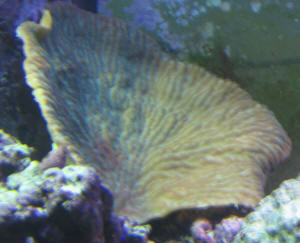
|
Hydnophora health decline. Env. and
allelopathy 6/21/07 Hello guys, how's things?
I'd like some help here, I'm having a Hydnophora that seems to
be dying <dying> there are a number of factors this could be
attributed to so i would like help in narrowing it down. The problem
started a few weeks ago, my Hydnophora simply just refused to inflate,
i <I> was also having problems with summer temperatures, it was
abnormally hot and tank temperatures were fluctuating with up to 6
degrees <Yikes! Too much> over 24 hours, down to 78-79 and
peaking at about 84, i managed to get that under control with a fan.
Then i also noticed that one of the surface powerheads had quit and a
thick scum layer on the surface formed, i did note some of my Palythoa
loose some color. <Both trouble> after a week or two of not
inflating it finally browned out, and now i am seeing bare skeleton in
the brown areas which suggest to me a tissue necrosis of sorts. I also
have a briareum colony in the tank, <...> possibly and possibly
not toxic <More likely so> (frequent water changes and carbon
usage), my candy cane and Favites brain who are both very very close to
it seem unaffected (just a few inches away, measured between expanded
polyps). with all these problem thou the other colonies have remained
healthy including my Montipora that's growing like a weed, i did
however note my Zoa frag being closed up alot <No such word> of
this period but seems to now open up again after i cleared the surface
scum. I have checked the water parameters, nitrate, calcium, PH,
hardness etc. and they all check out fine. Short summary of the
symptoms, deflated, brown out, tissue recession. so the big question,
what's killing my Hydnophora, the stress from the temperature
swings under control now) surface scum blocking out the light? now
under control) or allelopathy even thou its farther away from the
briareum colony than most of the other corals? and what can i do to
save it? Hope to hear from any of you soon, Best regards, Mark Forsling
<Is highly likely the variable environment, the encrusting Gorgonian
and Zoanthid at play here. Solutions? More water changes, carbon
filtration, moving/enlarging their world... Bob Fenner>
Coral Identification: Hydnophora
2/24/07 Hi, <Hello Iain, Mich with you tonight.> First of
all many thanks for your website - it's a real oracle of useful
information. <Glad you think so!> My reason for writing is
for a Coral ID (see attached photo and film). <Got the photo,
but was unable to open the movie.> I bought the coral in one of
my local shops (in the UK) and they said that someone has brought
it in as it had become too large. They suggested that it is a
Pocillopora but after consulting several books, websites etc
I'm not so sure as I haven't found anything that seems
similar. <Mmm, don't think it's a Pocillopora.>
It's skeleton, is white, branching and very fragile but most of
the time the polyps are out so it's hard to see. The polyps
extend 8 to 10mm during the day and come out to the point of making
the coral look like it's been veiled in a light velvet cloth.
It looks great and is growing well but I've never seen an
example of it before or since. Any ideas ? <I believe it is a
Hydnophora, also known as a velvet horn coral. More
here: http://www.wetwebmedia.com/merulinidae.htm > Many
thanks,
<You're welcome! -Mich>
Iain |
|
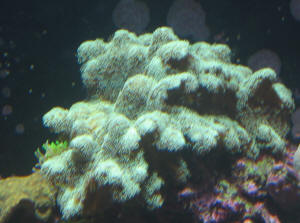
|
Hydnophora microconos comp. 11/27/06
Hello guys or gals, <Hey Ryan, JustinN with you today> I have a
question I hope you can help me with. <I'll do my
best> I've been doing all I can to find help with this problem
(books, forums, Internet searches) with no luck. I have this
brilliant fluorescent green and pink Hydnophora Microconos coral that
is receding on the "cones" only, the rest of the coral
appears to be fine. It's not all of the
"cones" just some of them, almost as if the flesh peeled
off. I also haven't seen the polyps opening very often,
which are very hard to see even when they are open. Should I
feed the coral something, if so, what? <These lovely,
yet extremely noxious corals are planktivores, and consume filter
feeding material, such as phytoplankton and zooplankton> I have
other types of Hydnophora that are fine and have been for a long
time. <Aha! We may have the culprit!> We also have a
Hydnophora Microconos at the store I work at that has been great for
years. So I am very confused, I don't know what would be
causing this. It's about 6 inches under water, which is
about 10-12 inches below my 250 watt metal halide bulb ( I acclimated
it slowly to the lighting ). I've had it in high flow,
moderate flow, and low flow, which doesn't seem to make a
difference. I don't want to bore you with my water
parameters, here's a quick look, all bad things are 0, calcium 425,
Alk 9 dKH, salinity 1.025, and temp 77-78. <All sounds
good here> Since I've received the coral it seems it has gotten
brighter in color, the cones which didn't recede are a more
brilliant pink which you would think would indicate good
health. Anyway, I'm confused about this, any help would
be appreciated. Thanks, Ryan. <Well, Ryan, the only thing
I can assume from what you describe is allelopathy between the
Hydnophora sp. in your tank. These beauties are some of the most
noxious around of corals, actively battling, and winning, with most
other species. Hope this helps you! -JustinN>
Re: Hydnophora microconos
11/28/06 Thanks Justin, I'll try removing the other varieties
of Hydnophora and see if that helps. <Sounds good, Ryan. Good luck!
-JustinN>
Re: Hydnophora microconos - A Follow-up
12/2/06 Thanks again for the help. <No problem,
Ryan... its why I do it> The Hydnophora is now doing great, polyps
are out, it's expanding like a balloon during lighting hours, it
looks better than ever. <Excellent to hear!> You hit
the nail on the head. Thanks for the help and the most
information regarding corals and fish on the net, Ryan. <Thanks for
the kind words, Ryan. We're here to help. I'll take this as a
chance to offer up a friendly reminder to everyone of the Christmas
spirit, and also of the donation box *grin* Every little bit helps!
-JustinN>
Coral ID 9/22/03 Hi crew; <howdy> I
am trying to id this coral but not having a lot of luck. I'm
thinking Pagoda or Merulina or Pachyseris but I'm not sure.
<its tough to say... the shot is distant and the polyp structure
is not clear/close... but it does resemble Mycedium or Oxypora.
Definitely not pagoda (Turbinaria) or Pachyseris> It is roughly
9" x 6". Small polyps. Here's a pic. Thanks for the
help. Mark & Heidi Vacca
<best regards, Anthony> |
|
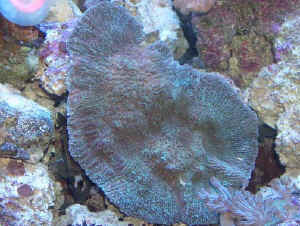
|
| Need Coral Id - 9/23/03 Anthony, thanks for
the stab. I read up on Mycedium & Oxypora and neither fit this
coral very well. I inferred from you reply that a close up of the
polyps might help. Here you go. Thanks again. Mark Vacca <quite
correct... and it does the trick. You have a nifty plating (less
common) Hydnophora species. If you have any doubts, please refer to
the works of Charlie Veron (the newer volumes if possible). Kind
regards, Anthony> |

|
|
Coral Question Follow Up-Alleged Merulina Sorry forgot
to send picture. Here it is. You also said to buy Eric
Bornemann's book "Aquarium Corals." Where can I
order it. Thanks again! <I reviewed your picture with several
friends and our general consensus is this is an octocoral,
possibly of the genera Sinularia or Nephthea. Eric
Bornemann's book is available at various aquarium e-tailers
or online bookstores. -Steven Pro>
Coral Question The LFS told me the name of this coral
was Merulina. Is this correct? If not what is the correct name?
<I don't mean to be rude, but how in the world would I
know. You have not sent a picture or even given a
description.> I have some mushrooms, pulsing Xenia, and this
piece in my 55 gallon tank along with a couple of fish. I do a
20% water change every 2 weeks and add iodine at about 4 drops
per day. Do I need to add anything else to the tank? <I
strongly urge you to buy Eric Bornemann's book "Aquarium
Corals." It will permit you to properly identify your coral
and will give you care information.> pH 8.4 Ammonia 0 Nitrite
0 Nitrate 0 Calcium 500ppm Phosphate 0.05 alkalinity 11.2 dKH or
4.0 mEq/l <The values given are all good. -Steven Pro>
|
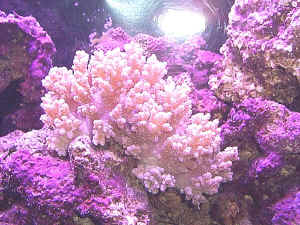 |
|
|

